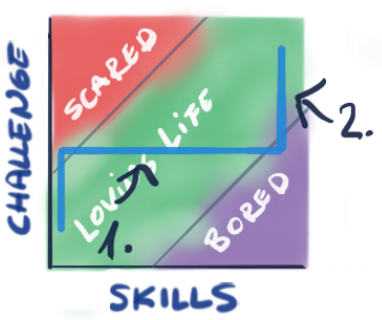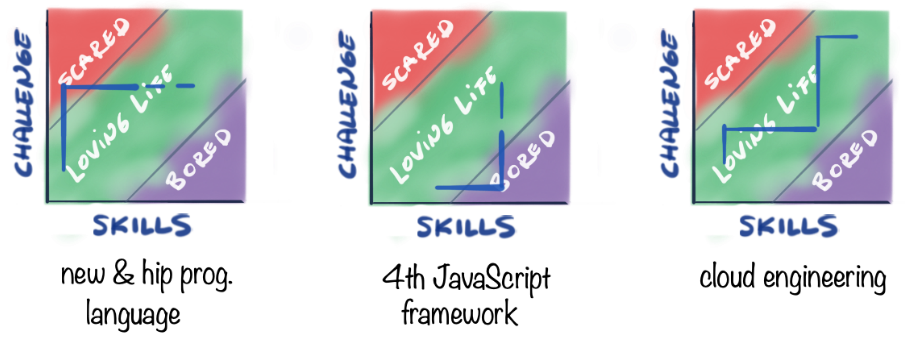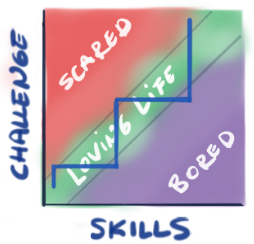Let’s explore how being in the “Zone” or being in “Flow” ain’t static and changes throughout your career.
Prerequisite to getting into Flow
Short feedback loops sets Software Engineering apart from every other profession. Just take a second and think about it. A Cellular Bioengineer applies a substance to a set of cells and has to wait for weeks to know the effect! Meanwhile, we get bored restarting Spring applications that take up to 2 minutes and we built the Quarkus framework (I’m loving it!!) to solve this.
The short feedback loop is a prerequisite to getting into Flow. Let’s take a mini step back and explore what we understand with flow.
Everyone knows what Flow is!
Nonetheless, a concise summary: Flow is the state you get in when solving a task that approximately matches your skill level, that keeps it challenging, but not to the point of frustrating you. And still not that simple as to make it frivolous and get you bored. For the people in this state (let’s call them Flowees) time passes quickly and they are full of love (forealdo), and it’s the time in which the Flowee experiences the most personal development.
The two properties that get a Flowee in Flow are:
- How challenging a task is and
- How skilled the Flowee is
Mihaly Csikszentmihalyi the creator of the Flow concept, charted these properties in axis Y and X respectively in the well known “Flow zone chart”
According to the chart inorder to have fun at work and improve yourself continuously you want to stay in the “Loving Life” zone (i.e. the Flow zone) and let me tell you Flowee, staying there is not an easy feat.
Principles of staying in Flow
As always, the principles are simple (but their implementation is difficult):
- If you are too skilled and you’re getting bored, then you pick up a more challenging task and
- If a task challenges you to the point of self-doubt, then you read about the technology or ask a friend to help you grasp the concept.
The principles are visually represented in the image below:
Basically, you need to be aware when a task is too difficult and you need new knowledge, and when your tasks are too easy and you need to increase difficulty (even if you need to change your company).
The technique of Parallel-Flowing
Considering the short feedback loop of our tasks and that you are a serious Flowee (and you shelter yourself from distractions), you can optimise the benefit of “Flow” by using it in multiple areas:
- Learning the latest programming language which is “Hip”
- Expanding your skill set in front-end
- Learning cloud engineering
As a result your personal Flow diagram will look as follows:
This is a beautiful Parallel-Flowing chart, it is the perfect depiction of a healthy career. If you maintain this, your skills will sky rocket! And let me tell you one tiny secret fellow Flowee, the improvement in skill in one area carries to other areas, directly or indirectly (explaining how this happens indirectly warrants another article).
Caution: Parallel-Flowing on itself does NOT depict a healthy career. Below we have an example of a terrible Parallel-Flowing chart, can you figure out why?
Here Parallel-Flowing is used as an escape mechanism! To clarify, as soon as the tasks get too challenging for the Flowee in area ‘a‘ he switches over to area ‘b‘, where after a period the tasks get difficult as well and then he switches over to area ‘c‘. Where if we look closely we notice another mistake! The tasks are kept at the same difficulty level, so there is no skill development at all.
In general, Flowees that use Parallel-Flowing as an escape mechanism are not aware of their mistake. Moreover they have some logical reasoning “My team needs my help in area ‘c‘” and “Sadly, I am scattered in different areas”, or my favourite “I wish I could get back to ‘b‘ as I was almost cracking it” and then does everything possible to just not get back to that area.
A note from me: I am writing a book, and I definitely am using my blog as an escape mechanism!
Tip: To prevent using Parallel-Flowing as an escape mechanism you need to only follow one rule: “Never, ever leave a task while it is too challenging“. Push through until you get into the Flow zone and then you may switch to another area.
The shrinking of the ‘Flow’ zone
We got back to where we started. My dear Flowee, I am sad to tell you that the area of the ‘Flow’ zone is not static. As you mature in your area of expertise, the region of “Flow” shrinks and proportionally the time spent in it dwindles. As a result every new task is either immediately ‘Boring‘ or if it’s ‘Challenging‘ you invest a short period of time to master the challenge, and it jumps right back into being boring again. Your Flow chart on the best-case scenario will get very Zig-zag-y, as shown below:
In the chart above, we can see that the “Flow” zone has shrunk and mathematically, keeping yourself in the “Zone” is more difficult as it has a smaller surface area. And practically, for most Flowees the chart above is not feasible, as only rare companies will have continuously tough challenges which require getting out of your comfort zone to accomplish the task. In most cases, you’ll end up doing a boring task that needs to be done, and you just take it one boring day at a time.
Tip: A solution to working on some ultra boring tasks is to invite colleagues who don’t know how to, and then to do it together. The act of explaining the intricacies of the subject will represent a challenge on its own and having a person to talk about something you enjoy is always fun.
Conclusion
To summarize make use of Parallel-Flowing. Pay attention when you are using it as an escape mechanism! And enjoy the “Zone” while it still didn’t collapse.
Another note from me: I’ll refine this article sometime in the future. Nonetheless, I hope you liked it in the current crude form as well and would love to hear your thoughts! Best!
If you enjoyed the article, please share and comment below!




